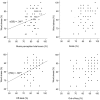Music and speech prosody: a common rhythm
- PMID: 24032022
- PMCID: PMC3759063
- DOI: 10.3389/fpsyg.2013.00566
Music and speech prosody: a common rhythm
Abstract
Disorders of music and speech perception, known as amusia and aphasia, have traditionally been regarded as dissociated deficits based on studies of brain damaged patients. This has been taken as evidence that music and speech are perceived by largely separate and independent networks in the brain. However, recent studies of congenital amusia have broadened this view by showing that the deficit is associated with problems in perceiving speech prosody, especially intonation and emotional prosody. In the present study the association between the perception of music and speech prosody was investigated with healthy Finnish adults (n = 61) using an on-line music perception test including the Scale subtest of Montreal Battery of Evaluation of Amusia (MBEA) and Off-Beat and Out-of-key tasks as well as a prosodic verbal task that measures the perception of word stress. Regression analyses showed that there was a clear association between prosody perception and music perception, especially in the domain of rhythm perception. This association was evident after controlling for music education, age, pitch perception, visuospatial perception, and working memory. Pitch perception was significantly associated with music perception but not with prosody perception. The association between music perception and visuospatial perception (measured using analogous tasks) was less clear. Overall, the pattern of results indicates that there is a robust link between music and speech perception and that this link can be mediated by rhythmic cues (time and stress).
Keywords: MBEA; music perception; speech prosody perception; visuospatial perception; word stress.
Figures






Similar articles
-
Prosody perception and musical pitch discrimination in adults using cochlear implants.Int J Audiol. 2015 Jul;54(7):444-52. doi: 10.3109/14992027.2014.997314. Epub 2015 Jan 30. Int J Audiol. 2015. PMID: 25634773
-
Prosody Perception and Production in Children with Hearing Loss and Age- and Gender-Matched Controls.J Am Acad Audiol. 2017 Apr;28(4):283-294. doi: 10.3766/jaaa.16001. J Am Acad Audiol. 2017. PMID: 28418324
-
Preserved appreciation of aesthetic elements of speech and music prosody in an amusic individual: A holistic approach.Brain Cogn. 2017 Jul;115:1-11. doi: 10.1016/j.bandc.2017.03.010. Epub 2017 Mar 31. Brain Cogn. 2017. PMID: 28371645 Free PMC article.
-
Congenital amusias.Handb Clin Neurol. 2015;129:589-605. doi: 10.1016/B978-0-444-62630-1.00033-0. Handb Clin Neurol. 2015. PMID: 25726292 Review.
-
[Music, brain and medicine].Tidsskr Nor Laegeforen. 1993 Dec 10;113(30):3743-7. Tidsskr Nor Laegeforen. 1993. PMID: 8278963 Review. Norwegian.
Cited by
-
Speech-in-noise, psychosocial, and heart rate variability outcomes of group singing or audiobook club interventions for older adults with unaddressed hearing loss: A SingWell Project multisite, randomized controlled trial, registered report protocol.PLoS One. 2024 Dec 4;19(12):e0314473. doi: 10.1371/journal.pone.0314473. eCollection 2024. PLoS One. 2024. PMID: 39630812 Free PMC article.
-
Musical improvisation enhances interpersonal coordination in subsequent conversation: Motor and speech evidence.PLoS One. 2021 Apr 15;16(4):e0250166. doi: 10.1371/journal.pone.0250166. eCollection 2021. PLoS One. 2021. PMID: 33857238 Free PMC article. Clinical Trial.
-
Perspectives on the rhythm-grammar link and its implications for typical and atypical language development.Ann N Y Acad Sci. 2015 Mar;1337:16-25. doi: 10.1111/nyas.12683. Ann N Y Acad Sci. 2015. PMID: 25773612 Free PMC article. Review.
-
Rhythmic pattern facilitates speech production: An ERP study.Sci Rep. 2019 Sep 10;9(1):12974. doi: 10.1038/s41598-019-49375-8. Sci Rep. 2019. PMID: 31506472 Free PMC article.
-
Relationship between Intelligence Quotient and Musical Ability in Children with Cochlear Implantation.Iran J Otorhinolaryngol. 2016 Sep;28(88):345-352. Iran J Otorhinolaryngol. 2016. PMID: 27738611 Free PMC article.
References
-
- Besson M., Schön D. (2012). “What remains of modularity?,” in Language and Music as Cognitive Systems, eds Rebuschat P., Rohrmeier M., Hawkins J., Cross I. (Oxford, UK: Oxford University Press; ), 283–291
LinkOut - more resources
Full Text Sources
Other Literature Sources

